Australia Diabetes Care Devices Market Size
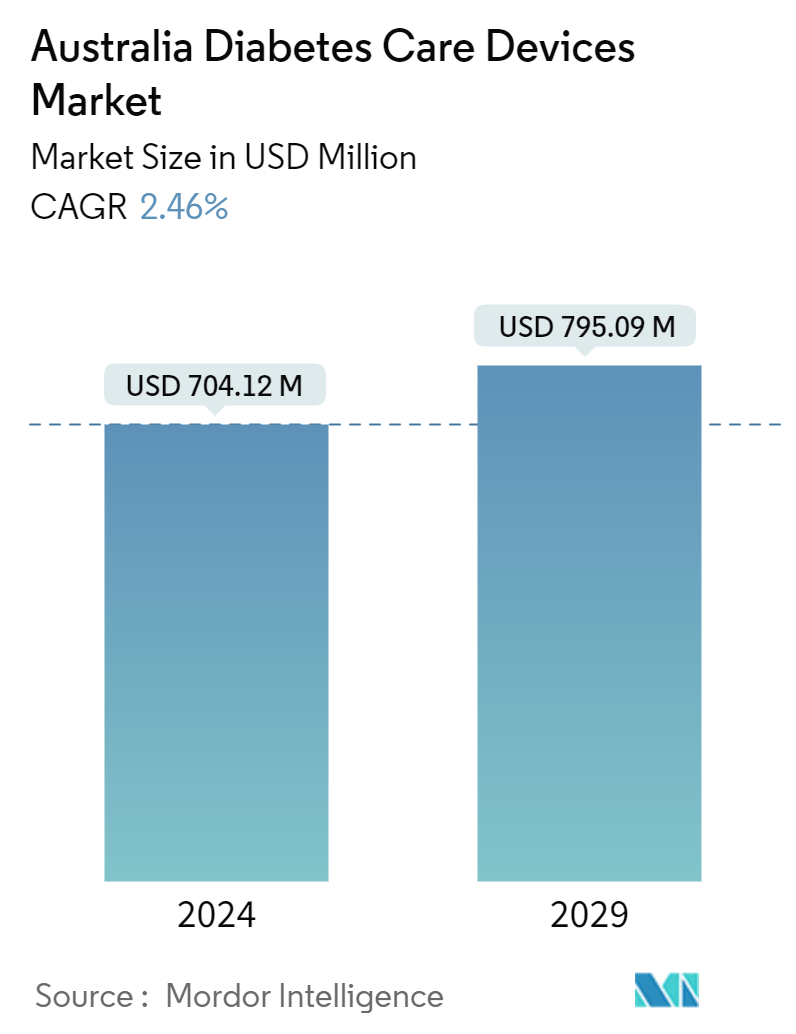
| Study Period | 2018 - 2029 |
| Base Year For Estimation | 2023 |
| Forecast Data Period | 2024 - 2029 |
| Market Size (2024) | USD 704.12 Million |
| Market Size (2029) | USD 795.09 Million |
| CAGR (2024 - 2029) | 2.46 % |
Major Players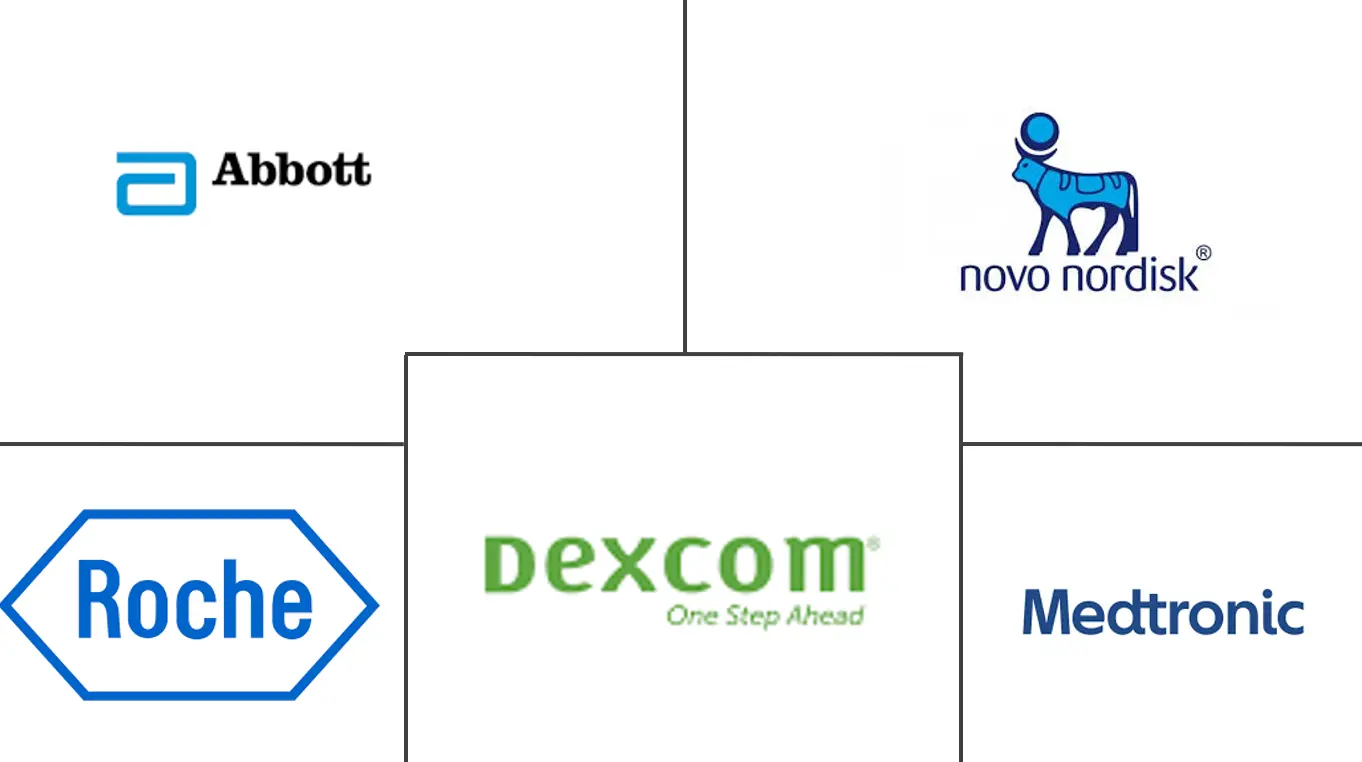
*Disclaimer: Major Players sorted in no particular order |
Need a report that reflects how COVID-19 has impacted this market and its growth?
Australia Diabetes Care Devices Market Analysis
The Australia Diabetes Care Devices Market size is estimated at USD 704.12 million in 2024, and is expected to reach USD 795.09 million by 2029, growing at a CAGR of 2.46% during the forecast period (2024-2029).
According to Australian National Health Survey, one in twenty (5.3%) people had diabetes. Type 2 diabetes was the most common type of diabetes (85.5%), followed by Type 1 diabetes (11.0%) and type not known by the person reporting (4.1%). The main diagnosis for diabetes patients is imbalances in blood glucose levels, which are not in compliance with the standard blood glucose levels. The general lab diagnostic tests can only help to diagnose the disease by physicians. Patients with more fluctuations in glucose levels need to get it checked every day. Patients administering insulin need to check their blood glucose levels frequently, adjust the doses of insulin, or change the medication, if necessary.
The rate of newly diagnosed Type 1 and Type 2 diabetes cases is seen to increase, mainly due to obesity, unhealthy diet, and physical inactivity. The rapidly increasing incidence and prevalence of diabetic patients and healthcare expenditure in developed countries are indications of the increasing usage of diabetic care products.
Moreover, the increasing adoption of insulin delivery devices and the rising prevalence of diabetes are driving the market growth. Leading manufacturers are focusing on technological innovations and the development of advanced products to gain a substantial share of the market.
The Australian National Diabetes Strategy is designed in response to diabetes and informs how existing limited healthcare resources can be better coordinated and targeted across all levels of Government. This Strategy identifies the most effective and appropriate interventions to reduce the diabetes impact in the community and leads the way internationally in diabetes prevention, management, and research.
Therefore, owing to the aforementioned factors the studied market is anticipated to witness growth over the analysis period.
Australia Diabetes Care Devices Market Trends
Increasing Diabetes Prevalence
According to Diabetes Australia, diabetes is the fastest-growing chronic condition in Australia, increasing faster than other chronic diseases such as heart disease and cancer.
Currently, almost 1.9 million Australians contain diabetes, including all types of diagnosed diabetes (almost 1.5 million known and registered) and undiagnosed type 2 diabetes (up to 500,000 estimated). The incidence of diabetes in children and young people is increasing. Almost all children and young people with diabetes include type 1 diabetes. In addition, children are developing type 2 diabetes at younger ages. Children and young people with type 1 and type 2 diabetes contain specific needs, such as access to care from a multidisciplinary pediatric diabetes team and to diabetes treatments and supporting technologies.
One of the main aims of diabetes treatment is to keep blood glucose levels within a specified target range. It can be achieved by balancing food with activity, lifestyle, and diabetes medicines. Blood glucose monitoring readings provide the information required to determine the best management strategy for diabetes. Keeping blood glucose levels within a target range can help reduce a person's risk of developing diabetes-related complications such as diabetic retinopathy, heart diseases, kidney diseases, etc.
The number of times people with diabetes use insulin will check their blood glucose levels varies according to several factors. People with type 2 diabetes who do not use insulin may not need to check their blood glucose levels as regularly. However, they may find a period of structured self-monitoring to be helpful.
The Australian Government includes an important role in maintaining access to affordable, high-quality medicines, devices, and services to support people with diabetes in self-management and treatment. It supports people with diabetes through the National Diabetes Services Scheme, the Pharmaceutical Benefits Scheme, the Insulin Pump Program, and Medicare and other funding. State and territory governments also include an important role in preventing and treating diabetes. All levels of Government share responsibility for health services in Australia and ensure that systems work together to produce the best options for people, regardless of their geographic location.
The Australian National Diabetes Strategy is designed in response to diabetes and informs how existing limited healthcare resources can be better coordinated and targeted across all levels of Government. This Strategy identifies the most effective and appropriate interventions to reduce the diabetes impact in the community and leads the way internationally in diabetes prevention, management, and research.
Thus, the market is expected to grow over the forecast period owing to rising prevalence and government support initiatives.
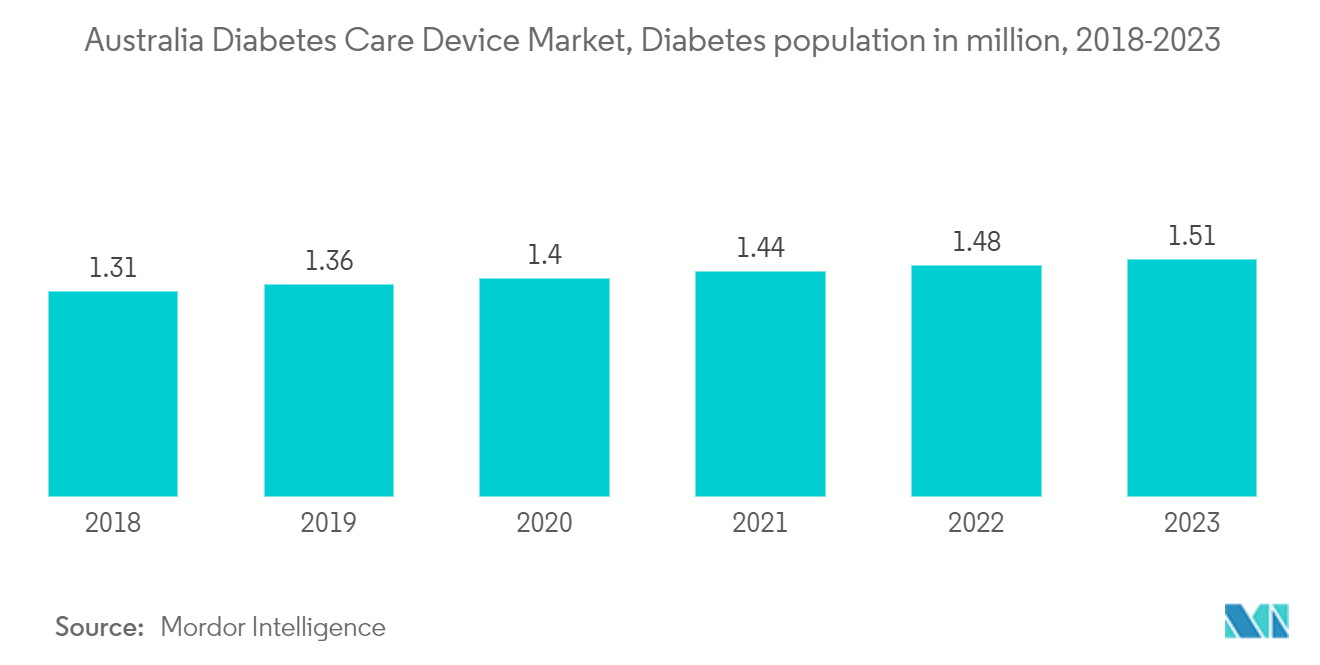
The Continuous Glucose Monitoring Segment is expected to dominate the Australian Diabetes Care Devices Market
The continuous glucose monitoring segment is expected to witness a CAGR of more than 12.7% over the forecast period.
A CGM is used by inserting a small sensor into the abdomen or arm with a tiny plastic tube known as a cannula penetrating the top layer of skin. An adhesive patch holds the sensor in place, allowing it to take glucose readings in interstitial fluid throughout the day and night. Generally, the sensors must be replaced every 7 to 14 days. A small, reusable transmitter connected to the sensor allows the system to send real-time readings wirelessly to a monitor device that displays blood glucose data. Some systems come with a dedicated monitor, and some now display the information via a smartphone app.
Continuous glucose monitoring became a popular alternative to the portable finger-prick glucometers available in the market for the convenience of diabetic patients. Continuous glucose monitoring sensors use glucose oxidase to detect blood sugar levels. Glucose oxidase converts glucose to hydrogen peroxidase, which reacts with the platinum inside the sensor, producing an electrical signal to be communicated to the transmitter. Various promising glucose-sensing technologies, from traditional electrochemical-based glucose sensors to novel optical and other electrical glucose sensors, are developed, positively impacting the market growth.
The National Diabetes Services Scheme (NDSS) is an initiative of the Australian Government. Once the patient is registered with the NDSS, blood glucose monitoring products can be accessed at subsidized costs. Registration with the NDSS is free and open to everyone in Australia with a Medicare card diagnosed with diabetes. The patient and a healthcare team member must fill out NDSS registration forms. The NDSS subsidizes the blood glucose monitoring strips. People with type 1 diabetes are eligible to access subsidized FGM and CGM.
Furthermore, the current continuous glucose monitoring devices can either display the trends in blood glucose levels by downloading the data or give a real-time picture of glucose levels through receiver displays. Continuous glucose monitoring devices are becoming cheaper with the advent of new technologies, like cell phone integration, which is likely to drive the segment.
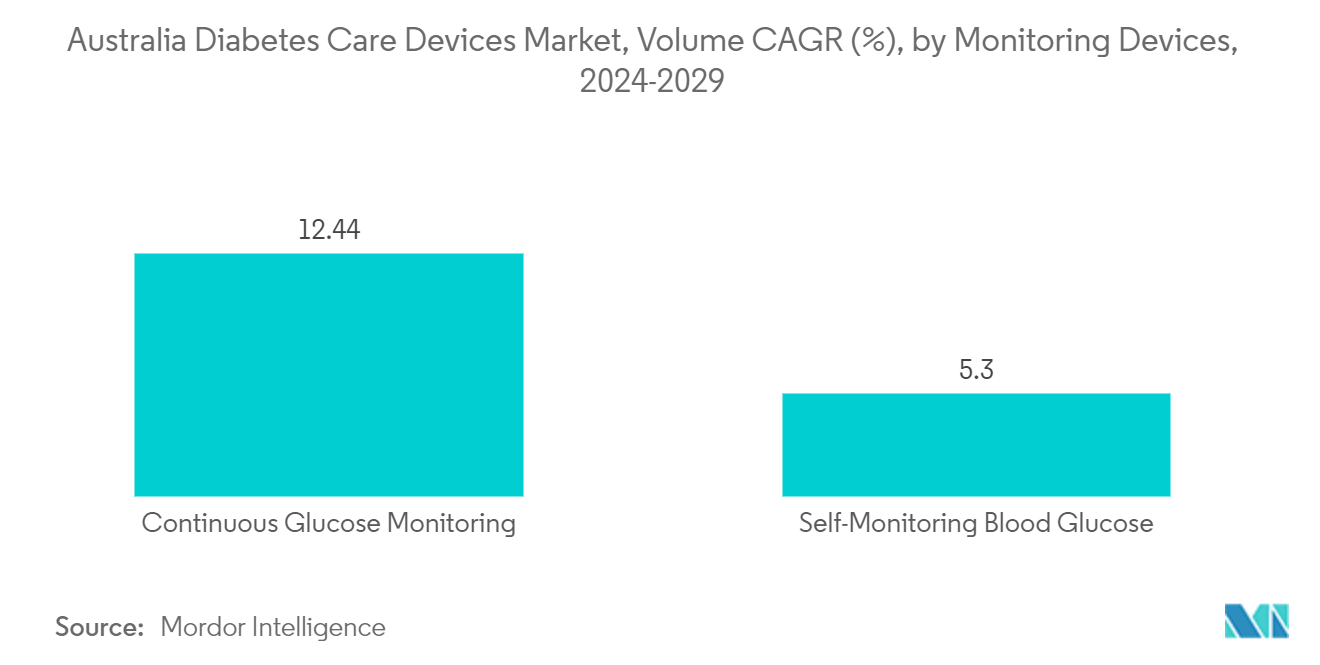
Australia Diabetes Care Devices Industry Overview
The Australian Diabetes Care Devices Market is semi consolidated, with few significant and generic players. Manufacturers drive constant innovations to compete in the market. The major players, such as Abbott and Medtronic, underwent many mergers, acquisitions, and partnerships to establish market dominance while adhering to organic growth strategies. It is evident from the R&D spending of these companies.
Australia Diabetes Care Devices Market Leaders
Abbott Diabetes Care
Novo Nordisk A/S
Medtronic PLC
Dexcom Inc.
Roche Diabetes Care
*Disclaimer: Major Players sorted in no particular order
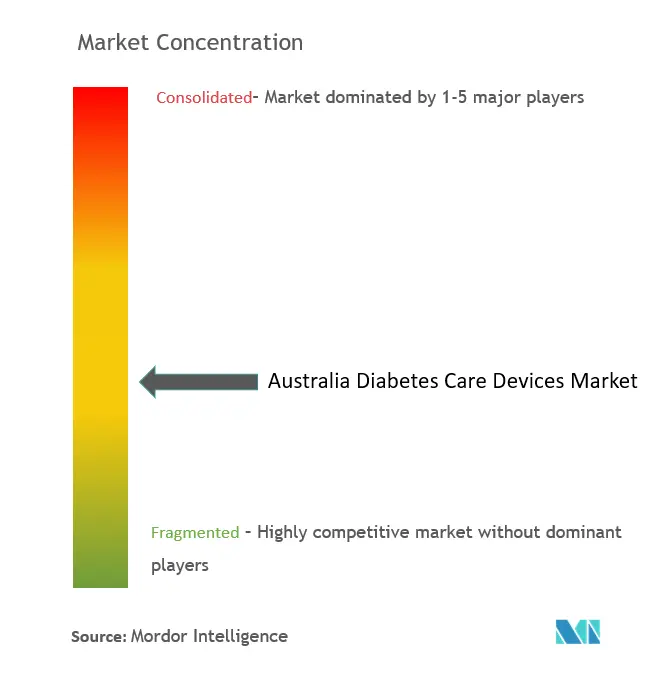
Australia Diabetes Care Devices Market News
- November 2023: The Australian government has granted approval for individuals to obtain prescriptions for continuous glucose monitoring (CGM) devices from various healthcare professionals, including General Practitioners (GPs), diabetes educators, diabetes clinics, Registered Nurses (RNs), and specialists.
- November 2022: Eli Lilly and Company announced that it would roll out its first connected platform, the Tempo Personalized Diabetes Management Platform. The technology aims to help adults with type 1 or 2 diabetes and clinicians make informed, data-backed decisions to manage treatment with Lilly insulins. The platform consists of three key components - the Tempo Smart Button, a compatible app; TempoSmart and a prefilled insulin pen, Tempo Pen. They work together to deliver personalized guidance for adults with diabetes.
Australia Diabetes Care Devices Market Report - Table of Contents
1. INTRODUCTION
1.1 Study Assumptions and Market Definition
1.2 Scope of the Study
2. RESEARCH METHODOLOGY
3. EXECUTIVE SUMMARY
4. MARKET DYNAMICS
4.1 Market Overview
4.2 Market Drivers
4.3 Market Restraints
4.4 Porter's Five Forces Analysis
4.4.1 Bargaining Power of Suppliers
4.4.2 Bargaining Power of Consumers
4.4.3 Threat of New Entrants
4.4.4 Threat of Substitute Products and Services
4.4.5 Intensity of Competitive Rivalry
5. MARKET SEGMENTATION
5.1 Management Devices
5.1.1 Insulin Pump
5.1.1.1 Insulin Pump Device
5.1.1.2 Insulin Pump Reservoir
5.1.1.3 Infusion Set
5.1.2 Insulin Syringes
5.1.3 Cartridges in Reusable Pens
5.1.4 Insulin Disposable Pens
5.1.5 Jet Injectors
5.2 Monitoring Devices
5.2.1 Self-monitoring Blood Glucose
5.2.1.1 Glucometer Devices
5.2.1.2 Blood Glucose Test Strips
5.2.1.3 Lancets
5.2.2 Continuous Glucose Monitoring
5.2.2.1 Sensors
5.2.2.2 Durables
6. MARKET INDICATORS
6.1 Type-1 Diabetes Population
6.2 Type-2 Diabetes Population
7. COMPETITIVE LANDSCAPE
7.1 Company Profiles
7.1.1 Novo Nordisk A/S
7.1.2 Sanofi Aventis
7.1.3 Eli Lilly
7.1.4 Roche Diabetes Care
7.1.5 Abbott Diabetes Care
7.1.6 LifeScan Inc.
7.1.7 ARKRAY Inc.
7.1.8 Ascensia Diabetes Care
7.1.9 AgaMatrix Inc.
7.1.10 Dexcom Inc.
7.1.11 Insulet Corporation
7.1.12 Medtronic
7.1.13 Ypsomed Holding AG
- *List Not Exhaustive
7.2 Company Share Analysis
7.2.1 Self-monitoring Blood Glucose Devices
7.2.1.1 Abbott Diabetes Care
7.2.1.2 LifeScan Inc.
7.2.1.3 Others
7.2.2 Continuous Glucose Monitoring Devices
7.2.2.1 Dexcom Inc.
7.2.2.2 Medtronic PLC
7.2.2.3 Others
7.2.3 Insulin Devices
7.2.3.1 Insulet Corporation
7.2.3.2 Novo Nordisk A/S
7.2.3.3 Others
8. MARKET OPPORTUNITIES AND FUTURE TRENDS
Australia Diabetes Care Devices Industry Segmentation
Diabetes care devices are the hardware, equipment, and software used by diabetes patients to regulate blood glucose levels, prevent diabetes complications, lessen the burden of diabetes, and enhance the quality of life. The australia diabetes care devices market is segmented into monitoring devices, management devices and geography. The report offers the value (in usd) and volume (in units) for the above segments.
| Management Devices | |||||
| |||||
| Insulin Syringes | |||||
| Cartridges in Reusable Pens | |||||
| Insulin Disposable Pens | |||||
| Jet Injectors |
| Monitoring Devices | |||||
| |||||
|
Australia Diabetes Care Devices Market Research FAQs
How big is the Australia Diabetes Care Devices Market?
The Australia Diabetes Care Devices Market size is expected to reach USD 704.12 million in 2024 and grow at a CAGR of 2.46% to reach USD 795.09 million by 2029.
What is the current Australia Diabetes Care Devices Market size?
In 2024, the Australia Diabetes Care Devices Market size is expected to reach USD 704.12 million.
Who are the key players in Australia Diabetes Care Devices Market?
Abbott Diabetes Care, Novo Nordisk A/S, Medtronic PLC, Dexcom Inc. and Roche Diabetes Care are the major companies operating in the Australia Diabetes Care Devices Market.
What years does this Australia Diabetes Care Devices Market cover, and what was the market size in 2023?
In 2023, the Australia Diabetes Care Devices Market size was estimated at USD 686.80 million. The report covers the Australia Diabetes Care Devices Market historical market size for years: 2018, 2019, 2020, 2021, 2022 and 2023. The report also forecasts the Australia Diabetes Care Devices Market size for years: 2024, 2025, 2026, 2027, 2028 and 2029.
Australia Diabetes Care Devices Industry Report
Statistics for the 2024 Australia Diabetes Care Devices market share, size and revenue growth rate, created by Mordor Intelligence™ Industry Reports. Australia Diabetes Care Devices analysis includes a market forecast outlook to 2029 and historical overview. Get a sample of this industry analysis as a free report PDF download.
